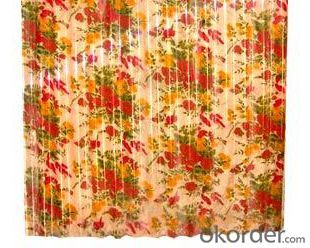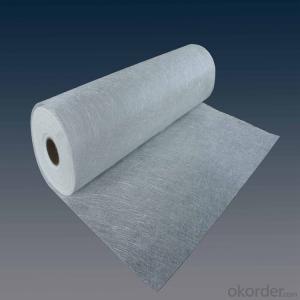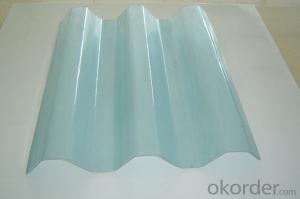Frp Roofing Panels - Fiber Reinforced Plastic Sheet Panel with 2.5 mm Thickness
- Loading Port:
- Tianjin
- Payment Terms:
- TT or LC
- Min Order Qty:
- 20000 m²
- Supply Capability:
- 100000000 m²/month
OKorder Service Pledge
OKorder Financial Service
You Might Also Like
Fiber Reinforce Plastic Sheet Panle with 2.5 mm Thinkness
Description
FRP roofing usually use a protecting facility in construction site,steel structured workshop and warehouse,canopy,packing sheds,corridors,studio light awning and greehouse ect as the excellent light transmittance.
Fiberglass roof is the more strengthened, safty, and more econimal greehouse pannel with the properties of waterproof,good light transmittance,heat insulation,strong impact resistant,withstand extreme temperature.
Photos



Product Traits and Application
1) Roofing skylight for office building, department store, hotel, stadium, school and hospital. |
2) soundproof shields on express ways. |
3)LED diffused, Advertising lamp boxes, sign board.Telepohne booths. |
4) Anti-riot shield, bullet resistant material, Bank ATMs. |
5) agricultural greenhouses, zoos, botanical gardens. |
6) Swimming Pools roofing/cover/sheet |
7)lighting for corridors, balcony, passages and subway entries, walkways. |
8) walls, roofs,windows,screens,shower enclosure and other indoor decoration material. |
9) Instrument and machine windscreen |
Product Advantage
1) The fiberglass content about 27%-30%.
2) Weather resistant and Self-clean ability
3) Excellent yellowness resistance
4) Strong impact resistant and low bending rate
5) Withstand extreme temperature from -38 degree to +110 degree for a long time
6) Aging resistant: specified F4 film added on surface and gel coat makes it endurable for long.
7) More strengthened, safer, cleaner and more economical greenhouse panel.
8) Mainly serve the big factory, warehouse, super markets and other steel-structured project
Specification
Fiber glass | ≥30% |
Thickness | 1.2mm,1.5mm,2.0mm or as customized |
Luminousness | Blue and green (75%) , white (68%) , no color (88%) |
Temperature | -40℃---+130℃ |
UV transmittance | ≤0.01% |
Useful life | 15 years |
FAQ
1.Which country do you mainly export to?
A: Our products are very popular in Mid East, India, South East Asia, Latin America, Africa.
2.Do You Arrange Shipment?
A:Yes, dear esteemed customers, for FOB or CIF price, we will arrange shipment for you. For EXW price, clients need to arrange shipment by themselves or their agents.
3.Q:Can you provide some samples?
A: Yes, of course. We will send you samples for your confirmation before you place firm orders.
- Q: Are FRP roofing panels environmentally friendly?
- Yes, FRP (Fiberglass Reinforced Plastic) roofing panels can be considered environmentally friendly for several reasons. First, FRP is a highly durable material that has a long lifespan, reducing the need for frequent replacements and minimizing waste. Additionally, FRP panels are lightweight, which means they require less energy to transport and install, resulting in a lower carbon footprint compared to heavier roofing materials. Furthermore, FRP panels are resistant to corrosion, chemicals, and UV radiation, which extends their lifespan and reduces the need for maintenance and chemical treatments. This reduces the use of harmful substances and minimizes the environmental impact associated with maintenance activities. Moreover, FRP roofing panels are often made from recycled materials or are themselves recyclable at the end of their lifespan. The ability to recycle FRP panels reduces the amount of waste going to landfills and contributes to a more sustainable waste management system. Lastly, FRP roofing panels have excellent insulation properties, which can help reduce the energy consumption of buildings by maintaining comfortable interior temperatures and reducing the reliance on heating or cooling systems. This energy efficiency contributes to a lower carbon footprint and a more environmentally friendly building operation. Overall, while it is important to consider the specific manufacturing processes and practices of individual FRP roofing panel manufacturers, FRP roofing panels are generally considered to be environmentally friendly due to their durability, recyclability, energy efficiency, and reduced maintenance requirements.
- Q: What is the expected lifespan of FRP roofing panels?
- The expected lifespan of FRP roofing panels can vary depending on various factors such as the quality of the panels, the installation process, and the environmental conditions in which they are exposed to. However, on average, FRP roofing panels can have a lifespan of around 20 to 30 years. FRP, also known as fiberglass reinforced plastic, is a durable and lightweight material that is resistant to corrosion, UV radiation, and extreme weather conditions. This makes it a popular choice for roofing applications, especially in areas with harsh climates. Proper installation and regular maintenance are crucial for maximizing the lifespan of FRP roofing panels. Regular inspections and cleaning can help prevent the accumulation of debris, which can deteriorate the panels over time. Additionally, applying a protective coating or sealant can further enhance the longevity of the panels by providing an extra layer of protection against wear and tear. It is important to note that the lifespan of FRP roofing panels can also be influenced by the specific brand or manufacturer. Some manufacturers may offer panels with extended warranties, indicating their confidence in the longevity of their products. Therefore, it is advisable to consult with a reputable supplier or manufacturer to determine the expected lifespan of specific FRP roofing panels before making a purchase.
- Q: Are FRP roofing panels available in different colors?
- Yes, FRP roofing panels are available in different colors.
- Q: Do FRP roofing panels require specific fasteners for installation?
- Yes, FRP (Fiberglass Reinforced Plastic) roofing panels do require specific fasteners for installation. These panels are typically lightweight and durable, making them suitable for a variety of roofing applications. However, to ensure proper installation and to maintain the integrity of the roof, it is important to use the appropriate fasteners. The specific type of fasteners needed for FRP roofing panels will depend on various factors, such as the type and thickness of the panels, the substrate material, and the environmental conditions. It is essential to consult the manufacturer's guidelines or seek professional advice to determine the correct fasteners for your specific installation. Common fasteners used for FRP roofing panels include stainless steel screws, nails, or bolts. These fasteners should be corrosion-resistant, as they will be exposed to outdoor elements. Additionally, they should be long enough to penetrate both the panel and the substrate securely. Proper fastening is crucial to prevent roof leaks, damage, and premature wear. If incorrect or inadequate fasteners are used, the panels may not be properly secured, leading to potential issues such as panel movement, water infiltration, or even structural failure. In summary, FRP roofing panels require specific fasteners for installation, and it is important to choose the right type and size of fasteners based on the manufacturer's recommendations and the specific requirements of your roofing project.
- Q: Are FRP roofing panels resistant to cracking?
- Yes, FRP roofing panels are resistant to cracking.
- Q: Can FRP roofing panels be installed on existing roofs?
- Yes, FRP (Fiberglass Reinforced Plastic) roofing panels can be installed on existing roofs. However, certain factors need to be considered before installation. Firstly, the condition of the existing roof needs to be assessed to ensure it is structurally sound and can support the weight of the FRP panels. Additionally, the compatibility of the existing roof material with FRP panels should be evaluated. If the existing roof is in good condition and compatible with FRP panels, the installation process typically involves cleaning the roof surface, removing any loose or damaged materials, and preparing it for the installation of the FRP panels. This may include applying primer or adhesive to the roof surface to improve adhesion. It is important to follow the manufacturer's guidelines and recommended installation methods to ensure a proper and secure installation. Additionally, it is advisable to consult with a professional roofing contractor or FRP panel supplier for expert advice and assistance during the installation process. Overall, while FRP roofing panels can be installed on existing roofs, it is crucial to consider various factors and consult professionals to ensure a successful installation that meets all safety and performance requirements.
- Q: Are FRP roofing panels resistant to extreme temperatures or thermal expansion?
- Yes, FRP (Fiberglass Reinforced Plastic) roofing panels are resistant to extreme temperatures and thermal expansion. FRP panels are designed to withstand a wide range of temperatures without losing their structural integrity. They are capable of withstanding both high and low temperature extremes, making them suitable for various climates and environments. Thermal expansion is a natural occurrence in all materials when exposed to heat. However, FRP panels are specifically engineered to minimize the effects of thermal expansion. The combination of fiberglass reinforcement and the polymer matrix of the FRP panels allows them to expand and contract without compromising their overall strength. FRP roofing panels have a low coefficient of thermal expansion, meaning they expand and contract at a relatively low rate compared to other materials. This characteristic ensures that they maintain their shape and stability even when subjected to extreme temperature fluctuations. Additionally, FRP panels have excellent insulation properties, which further helps in regulating temperature and reducing thermal expansion. This insulation capability helps to minimize the stress caused by temperature changes, ensuring that FRP roofing panels can withstand extreme temperatures without any significant issues. In conclusion, FRP roofing panels are indeed resistant to extreme temperatures and thermal expansion. Their unique composition and design make them highly durable and capable of withstanding a wide range of temperature fluctuations without compromising their structural integrity.
- Q: Can FRP roofing panels be used for architectural designs?
- Yes, FRP roofing panels can be used for architectural designs. These panels offer a wide range of design possibilities due to their flexibility, durability, and versatility. FRP roofing panels can be molded into various shapes, sizes, and colors, allowing architects to create unique and visually appealing designs. Additionally, FRP panels are lightweight, making them suitable for both small and large-scale architectural projects.
- Q: Can FRP roofing panels be used in areas with high levels of vibration?
- Before deciding to use FRP (Fiberglass Reinforced Plastic) roofing panels in areas with high levels of vibration, it is crucial to consider certain factors. The durability and flexibility of FRP panels make them resistant to cracking or breaking under normal vibrations. However, in areas with extremely high vibrations, such as near heavy machinery or in earthquake-prone places, it is advisable to consult a structural engineer or roofing professional to assess the suitability of FRP panels. Moreover, the installation of FRP panels in high-vibration areas should be approached with great care. It is essential to use proper fastening and anchoring methods to ensure the secure placement of the panels. Additionally, employing vibration-damping materials or techniques, like rubber gaskets or isolation pads, can help minimize the impact of vibrations on the panels. It is also worth noting that the stiffness and thickness of FRP panels can vary, affecting their performance in high-vibration environments. Thicker and more rigid panels generally exhibit better resistance to vibrations compared to thinner and more flexible ones. In conclusion, while FRP roofing panels can be employed in areas with high levels of vibration, it is crucial to evaluate the specific conditions and seek professional guidance to ensure the panels can withstand the vibrations and maintain their structural integrity.
- Q: Are FRP roofing panels compatible with rooftop gardens or green roof systems?
- Yes, FRP roofing panels are compatible with rooftop gardens or green roof systems. These panels provide a strong and durable roofing solution while allowing for the installation and support of vegetation and greenery on the roof. The lightweight nature of FRP panels makes them suitable for rooftop gardens, as they do not add excessive weight to the structure. Additionally, FRP panels offer excellent weather resistance and protection against UV rays, ensuring the longevity and functionality of the green roof system.
Send your message to us
Frp Roofing Panels - Fiber Reinforced Plastic Sheet Panel with 2.5 mm Thickness
- Loading Port:
- Tianjin
- Payment Terms:
- TT or LC
- Min Order Qty:
- 20000 m²
- Supply Capability:
- 100000000 m²/month
OKorder Service Pledge
OKorder Financial Service
Similar products
Hot products
Hot Searches
Related keywords





























